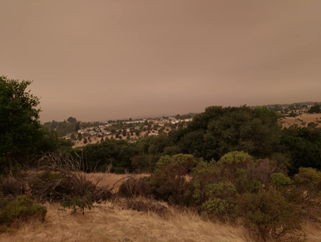Potential Hazards of Wildfire Ash in the Garden
by Georgianne Messina

In 2020, many of us were greeted with the eerie, apocalyptic appearance of the morning sky as a result of the California wildfires. Wildfires continue to affect the State of California. That year, California had the largest number of wildfires recorded in its history. Since over ten thousand structures were consumed in those fires, the composition of smoke particulate, and ash was not solely from trees, grasses, and other natural sources. Ash from these fires can be deposited on plants, soil, and water.
At the time of writing this blog, CalFire had reported over 6000 incidents with over 400 structures having been damaged or destroyed. The Dixie Fire is the 2nd largest fire in California history, approaching 1 million acres burned at the time of writing.
Questions Received at the Help Desk
As the frequency and intensity of these fires has increased, we have received many questions about how to manage ash in the garden including: “How do I manage the visible residue of ash deposited on plants?”, “Does the ash need to be removed or can I leave it?” And many other similar questions asked about the safety of eating fruits, vegetables, and herbs from home gardens.
While there has been research done on the risk of breathing in air pollutants from wildfire smoke, there is little research on the risk to human health from the potential of ingesting contaminants from smoke and ash on produce.
Q: Visible ash on my plants – should I clean it off?
Short answer: yes.
- Irrigate the plant,
- Hose down the leaves and fruit, and
- Lightly fertilize to promote healthy roots and
new growth.
Q: My fruits and vegetables have visible ash residue, is my produce safe to eat?
Studies and testing of produce exposed to wildfire ash has not been widely performed in Alameda County. After the 2017 Sonoma County wildfires, there was testing performed in Sonoma County. The study analyzed produce grown in three different sites and found no detectable contaminant levels in 12 of the 13 sites. The results indicated that there was a low concern regarding the consumption of locally grown produce in this area. Follow some simple practices to limit exposure to substances contained in the ash in your garden by:
- Thoroughly wash your produce.
- Remove outer, older leaves of green leafy vegetables.
- Peel root vegetables.
Q: Is my soil contaminated?
If you are curious or concerned, you can test your soil. Ask for a heavy metal panel. According to the University of New Hampshire Extension, “Heavy metals are a class of elements that include lead, copper, arsenic, and cadmium, and can be toxic to humans and plants if ingested in high enough quantities.” Consider that any contaminants discovered may have been there before the ash was deposited. This fact may set your mind at ease: soils that were very close to the burn areas in Sonoma County showed low concentrations of contaminants.
Q: How should I prepare my garden for the next season after a wildfire?
According to research performed in Sonoma County, “Add compost and 'clean' soil to your beds to dilute contaminants. Some research suggests that adding compost increases soil microorganisms and fungi that break down organic chemicals (like dioxins) in soil, and would be appropriate for low-level contamination, while compost high in phosphorous can help bind lead in soil.”
The uptake of contaminants in your fruits and vegetables is dependent on factors such as the amount and types of contaminants in the soil and the type of plant. Learn more about soil testing.
Summary
The likely routes of exposure to ash containing contaminants are inhalation, skin contact, and direct ingestion of ash or soil contaminated by the ash.
- Practice good hygiene,
- Thoroughly wash fruits and vegetables and peel root vegetables.
- Wear protective clothing while working in your garden or performing clean up; and,
- Submit soil for testing, where there is a great concern.
Most importantly, take comfort in Dr. Hettiarachchi’s, a scientist at Kansas State University, words: “Urban gardens give people access to fresh fruits and vegetables and are also good for physical, mental and community health."
Still need help or have more questions?
Our Help Desk is standing by if you still have questions. You may email us at acmg@ucanr.edu or use our online tool to share pictures and ask for specific help.
References
- Soil Testing for the Home Gardener - https://ucanr.edu/sites/MG_Alameda/files/348076.pdf
- I’m Glad You Asked: The Effect of Smoke and Ash on Plants https://botanicalgarden.berkeley.edu/glad-you-asked/amoke-ash-plants
- Final Report Cumulative Risk Assessment of Local Produce Exposed to Urban Wildfire Smoke https://ucanr.edu/sites/SoCo/files/308873.pdf

